Central Building
The building was designed as an architectural focus, placed in the centre between the ski jumping and cross-country segment of the Nordic Centre Planica. The underground part of the building along the path to the valley of Tamar forms the highest terrace of the terrain. At the edge of the terrace stands the concentric architecture of the visible part of the building, which seeks to equally interlace all the natural and cultural elements of the area with its dynamic content and image.
The purpose of the building changes by adapting the content regarding the seasons or for the requirements of organising competitions. It primarily serves for tourist visits for the presentation of natural, cultural and sporting characteristics of Planica and for recreational and professional athletes for organising training sessions and competitions. The building by integrating two wind tunnels, the indoor cross-country trail, interpretation centre and an extremely multi-functional design achieves uniqueness in world standards.
Project
The project included a land area of 61,000 m2, of which the built-up area of the building occupies 5,700m2. Within the project the road to the valley of Tamar was also reconstructed with outer terraced parking spaces in the total area of 10,300m2. The building includes 8,500m2 of indoor net area in seven floors. The building is conceptually and constructionally divided to the underground part, which occupies 85% of indoor area and the cylindrical above ground part.
The architectural appearance of the above-ground part of the building is made of wooden façade in a modern interpretation of a Slovenian “gank”, which is a wooden covered balcony on traditional Alpine houses. This allows the 360° experience of the nature’s landscape, sports facilities and events. From the entrance hall, which is accessible from the platform opposite to the Gorišek Brothers Flying Hill, the visitor is faced with a horizontal and a vertical wind tunnel, which form the closed air loop over six floors of the building. The so-called interpretation centre continues in the upper floors, which interactively presents the history of Planica and that of the Nordic disciplines and ends in a glass pavilion at the panoramic roof. The floor plan and interior design of the interpretation centre enable simple reorganisation during events, when hosting invited visitors.
Under the concentric part of the building there are four underground floors, where the lowest is intended solely for the engine room of the wind tunnel. The higher floors are technical facilities with the heating station and fire safety systems with a sprinkler pool. The floor below the entrance hall, which is connected via an underground corridor directly to the ski jumping arena includes a first aid room, changing rooms with toilets and rooms for relaxation for athletes.

The larger part of the underground building is occupied by the three-floor multi-purpose hall designed with a flat pavement and green roof, which on the outside forms the highest terraces of the existing outer parking places along the path to the valley of Tamar. The lower terrace serves as a bus stop and the higher terrace as the cross-country arena in the winter or a football field in summer. The height difference between the terraces is carried out in inclined greened fill up with individual cuts in for entrances and drive-ins with highlighted elements of roof lights and air-vents. All floors of the underground hall can be used in summer to store snow and organisation of the indoor cross-country skiing trail of 800m in length and in winter as a parking garage for 178 vehicles. During winter events the lowest floor can be organised as a press centre for 300 persons, the intermediate as changing rooms and toilet rooms for 420 competitors and the upper level for setting up service rooms for 40 competitive teams. The centre of the cross-country skiing arena and the upper floor of the hall are directly connected via an underground corridor.
FUNCTIONAL SCHEME
- main entrance hall
- entrances
- +8,82
- +4,25
- +0,00 = +951,60
- -4,59 / -6,29
- -8,04 / -10,54
- -11,89
- -17,48
WIND TUNNEL AIR LOOP
- main entrance hall with the vertical and horizontal wind tunnel
- wind tunnel air loop
- air loop areas
SUMMER SCENARIO
- main entrance hall
- interpretation centre
- visitors
- cross-country skiing trail inside the hall
- relaxation and changing rooms for athlets
- football field
WINTER SCENARIO
- main entrance hall
- interpretation centre
- visitors
- parking garage traffic circulation
- parking places
- relaxation and changing rooms for athlets
- cross-country ski arena
WINTER EVENTS
- main entrance hall
- cross-country ski arena
- competitors, press, first aid
- changing rooms and service areas for competitive teams, press centre, first aid area
- invited visitors
- VIP areas
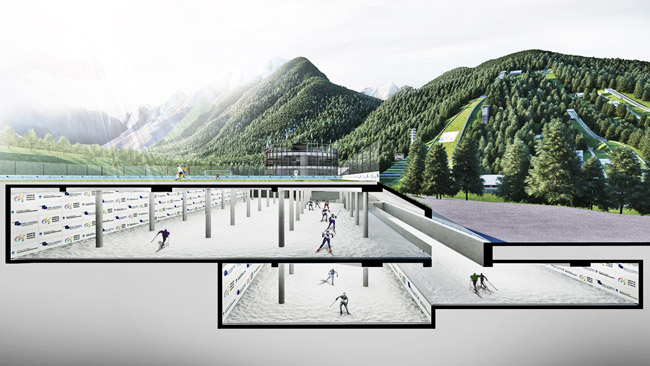
Summer scenario
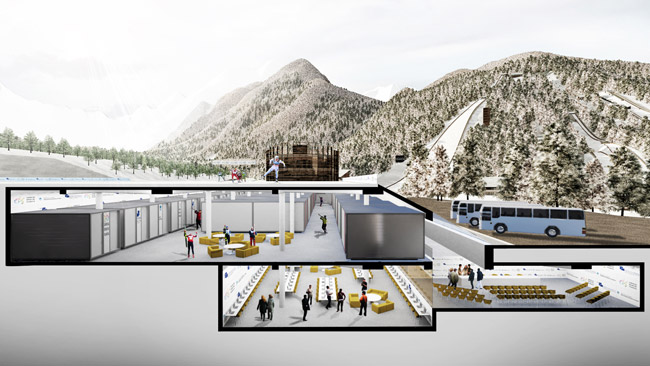
Winter scenario
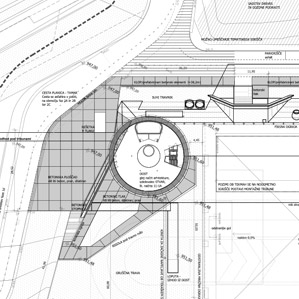
Situation
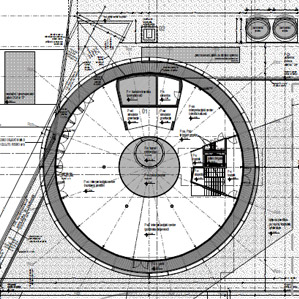
Ground floor
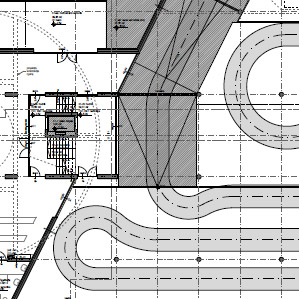
First undergroud floor
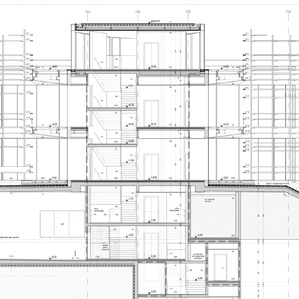
Staircase profile
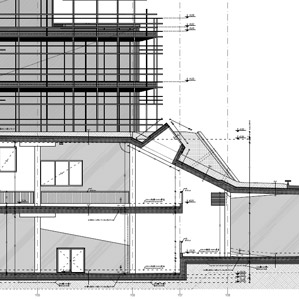
Multi-purpose hall profile
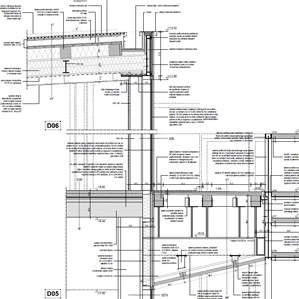
Details
Construction
Construction began in the autumn of 2014 and took place incessantly also in winter months up to its opening in December of 2015, Before starting the foundations wide excavation of the construction pit took place in the extent of 55,000 m3, of which 20,000m3 was used for backfilling the underground part of the building.
The foundations and basement floors were made of reinforced concrete in semi staggered raster of 8m x 8m, which derives from the organisation of indoor parking spaces. The outer wall façade of basement floors is done as ventilated with metal coating in which among other things also all entrance doors and inclined sectional doors of the multi-purpose hall were integrated. The architectural focus and implementation challenges of the underground part of the building are surely the reinforced concrete roof lights in the shape of inclined truncated cones and fluid design of the portals of the main entrance and drive-ins in the basement hall. The sheathing elements for exposed concrete were made individually based on 3D architectural plans.
The building above ground is designed as a cylinder of outside diameter of 29m, made in combination from steel and reinforced concrete construction. All floors above the entrance halls are visually connected through the air void in the centre of the cylinder, which concludes at the top with a walk-glass roof at the level of the roof terrace. The pavilion on the roof terrace is made of steel trusses and functionally presents the head of the reinforced concrete communication core. The façade is completely glazed for thermal insulation, in the case of the pavilion with the use of curved glass. The final outer image is achieved with horizontal blinds made of glued laminated larch, which are mounted on the basic structure of the building through steel substructure. The density of the blinds is determined by the exposure to sunlight, the internal functional structure of the building and the interesting views. The selection of larch wood was made for all the buildings at Planica.
The building installations were adapted to the planned multi-purpose use and controlled via the central control system. The underground hall is among other things equipped with a floor heating or cooling system with the possibility of regulating the temperature of the concrete core between -10 and +25 °C via heating pumps, which exploit the groundwater from wells in the area of Planica. The outside arrangement includes all the necessary utility connections for different scenarios of organising events.
Exceptional effort has been made in installing and calibrating the vertical and horizontal wind tunnel, which are connected to a single air loop. The plant among other things includes two fans of diameter over 300 cm and total power of 1.8 MW, which are placed in the lowest basement floor. The vertical wind tunnel is done in arc safety glass with the total height of 600 cm and diameter of 360 cm. The horizontal wind tunnel is 600 cm in length, 330 cm in height and 480 cm in width. The airflow reaches the maximum speed of up to 250 km/h in the vertical wind tunnel.
| Building: | Central building Planica |
| Architecture: | STVAR architects (Ales Vodopivec, Marko Smrekar) |
| Landscape architecture: | Studio AKKA (Ana Kucan, Luka Javornik) |
| Building construction: | Grad-art d.o.o. |
| Installations: | I.S.P. d.o.o., ELDATA d.o.o., Eso projekt d.o.o., El-ari d.o.o. |
| Location: | Slovenia, Planica valley, +951,60 m.a.s.l. |
| Size: |
61.000 m2 - planning land area 8.500 m2 - internal net building area |
| Chronology: |
competiton 2009 project 2010 - 2013 realisation 2014 - 2015 |
| Investment amount: | 10.000.000 EUR |
